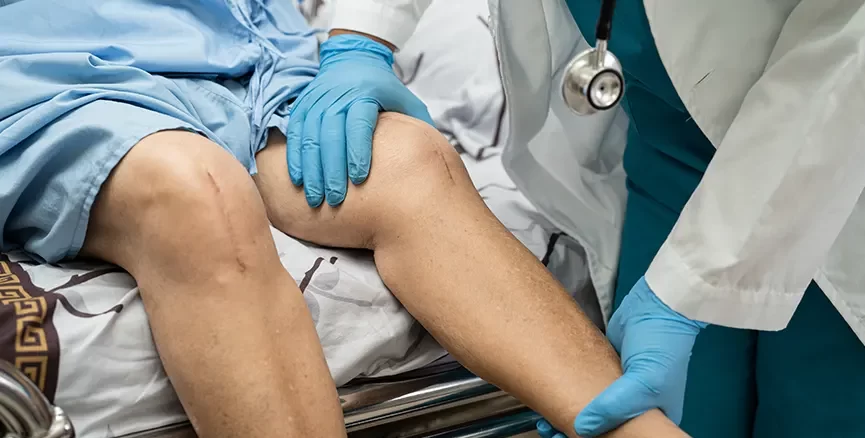- November 12, 2018
- modir
- Comment: 0
- Arthroplasty
What is arthroplasty?
The definition of arthroplasty is surgical joint replacement. During the procedure, your healthcare provider removes a damaged joint and replaces it with an artificial joint. The artificial joint (prosthesis) can be metal, ceramic or heavy-duty plastic. The new joint looks like the natural joint and moves in a similar way.
Surgeons can replace joints in any part of your body, but the most common types of arthroplasty are hip replacement and knee replacement.
Most people who get this procedure need a total joint replacement. A small number of people are good candidates for a partial joint replacement. This procedure only replaces the part of the joint that’s damaged. Recovery time for arthroplasty varies. It depends on your age and lifestyle, the type of procedure and the joint you have replaced.
Who needs arthroplasty (joint replacement)?
Your surgeon may recommend arthroplasty if you have:
• Joint pain that hasn’t gotten better with nonsurgical treatments such as physical therapy (PT), medications, bracing, injections, walking assistive devices and rest.
• Joint stiffness and limited mobility that make it difficult or impossible for you to do your everyday activities.
• Swelling (inflammation) that doesn’t improve with medications or lifestyle changes.
These symptoms can result from several conditions, including:
• Arthritis, specifically osteoarthritis.
• Rheumatoid arthritis.
• Fractures, including a hip fracture.
• Joint abnormalities, such as hip dysplasia.
• Avascular necrosis (lack of blood supply to the bone).
These symptoms can result from several conditions, including:
• Arthritis, specifically osteoarthritis.
• Rheumatoid arthritis.
• Fractures, including a hip fracture.
• Joint abnormalities, such as hip dysplasia.
• Avascular necrosis (lack of blood supply to the bone).
What happens during arthroplasty?
You may have your surgery in an outpatient clinic or at a hospital. The technique your surgeon uses varies depending on the type of surgery and the joint you need replaced. Right before your procedure, you will receive anesthesia. This ensures you won’t feel pain during arthroplasty.
Your surgeon makes incisions (cuts) and removes the damaged joint. Then they replace it with an artificial joint. They use stitches, staples or surgical glue to close the incisions. Your provider wraps the joint in a bandage. You may also need a brace or sling.
Surgeons can do some joint replacement procedures using minimally invasive techniques. These techniques use fewer incisions and special tools. The recovery time for minimally invasive procedures can be less than it is for traditional procedures. Your surgeon will recommend the most appropriate procedure for you.
What happens after arthroplasty?
Depending on the type of procedure you have, you may go home the day of surgery, or you may need to stay in the hospital for a day or two. Talk to your provider about planning for recovery. You will need to have someone drive you home. You may also need help getting around or performing tasks like laundry or bathing.
After surgery, you will feel some pain. The first few days after your procedure, you should:
• Avoid physical activity. Take time to rest as you recover from surgery. Your provider may recommend placing ice or a cold compress on the new joint for about 20 minutes at a time.
• Perform your physical therapy and home exercise program as prescribed. It is important to follow your provider’s instructions. They will not only help in your recovery to restore function but also help to protect the new joint.
• Elevate. Depending on the joint you had replaced, your provider may recommend keeping the joint elevated while you rest. For example, if you had a knee replacement, rest with your foot on a stool or chair instead of the floor.
• Keep your incisions clean and covered. Follow your provider’s incision care instructions carefully. Ask your provider when you can remove the dressing, take a shower or bathe after your procedure.
• Take pain medication. Your provider may recommend over-the-counter nonsteroidal anti-inflammatory drugs (NSAIDs) or prescription pain medication. Be sure to follow your provider’s instructions when taking pain medication. You may also need drugs to reduce swelling or prevent blood clots.
What are the advantages of arthroplasty (joint replacement)?
Joint replacement procedures can help you move without pain and stiffness. After a joint replacement, many people can take part in activities they once enjoyed. These surgeries greatly improve quality of life and overall health by allowing people to have an active lifestyle.
What are the risks or complications of arthroplasty?
As with any surgery, there is a risk of complications from arthroplasty. The risks include:
• Blood clots.
• Infection.
• Injury or damage to nerves around the replaced joint.
• Joint stiffness, weakness or instability that may lead to a fracture.
• Problems with the new joint, including dislocation.
• You have a higher risk of complications from arthroplasty if you have certain health conditions. Before surgery, tell your provider if you have diabetes, hemophilia or an autoimmune disease such as lupus. These conditions can make recovery from joint replacement more difficult.


